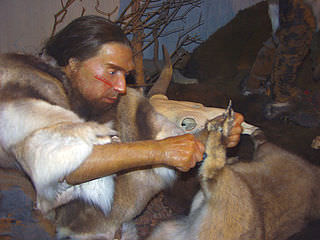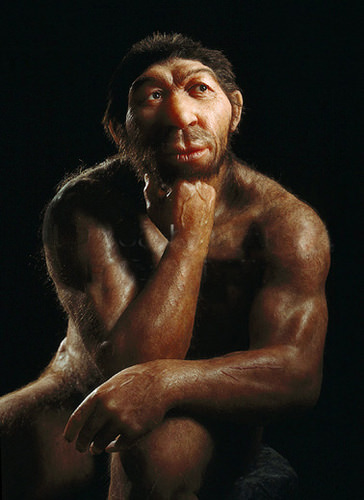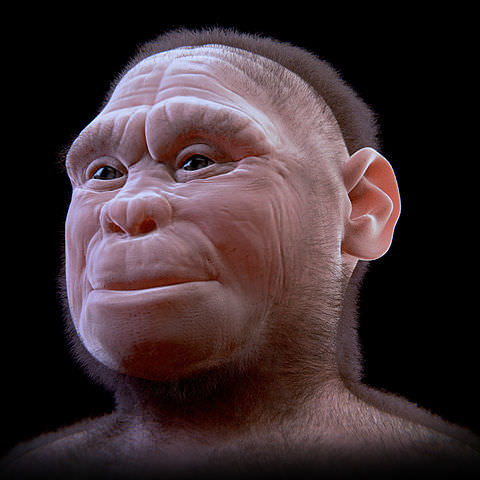7.6 尼安德特人和其他考古人类
章节大纲
-
Brutes or Brains?
::布鲁斯还是大脑?This picture was created to present a sympathetic view of the humans commonly known as Neanderthals. Neanderthals lived tens of thousands of years ago throughout much of the Old World. They were skilled hunters of big game, and they were clever enough to survive periods of glaciation. Nonetheless, until fairly recently, Neanderthals were commonly thought of as brutish, crude, and stupid. These characterizations derive from early 20th century ideas about them based on incorrect interpretations of their fossilized remains. In this concept, you will learn more about these and other fascinating archaic humans, some of whose we share.
::这幅画是用来展示对人们的同情感的,人们通常称之为尼安德特人。在数万年前,尼安德特人生活在数以万计的古老世界的大部分地方。他们是大游戏的熟练猎手,他们聪明到足以活过冰川的时期。然而,直到最近,尼安德特人一直被认为是野蛮、粗糙和愚蠢的人。这些特征来自20世纪初关于他们的想法,其基础是对其化石残骸的不正确解释。在这个概念中,你会更多地了解这些和其他迷人的古老人类,其中一些是我们共同认识的。Who Were Archaic Humans?
::谁是考古人类?Beginning about half a million years ago, a number of of Homo co-existed that are grouped into a broad category called archaic humans . This category typically includes Neanderthals and two other now-extinct Homo species, which are described below. Archaic humans are represented by that differ from their Homo erectus or Homo heidelbergensis predecessors, but also from modern humans in the species Homo sapiens . For example, archaic humans have brow ridges, a sloping forehead, and an elongated skull. Because they differ from modern humans in these ways, they are generally placed in separate species from Homo sapiens.
::从大约50万年前开始,许多同性人共同存在,他们被归为称为古老人类的大类。这一类人通常包括尼安德特人和另外两种现已灭绝的同性物种,如下文所述。 古人所代表的是不同于其原同性勃起人或同性性血型人,也不同于现代人。 例如,古老人类有眉脊、斜额头和长骨。 由于它们与现代人不同,因此通常被置于与同性人不同的物种中。The brain size of archaic humans is similar to that of modern humans, so they are sometimes classified as sub-species of Homo sapiens. There is also recent DNA evidence of interbreeding among archaic humans and modern Homo sapiens , so placing them in separate species may not be justified on a biological basis. Nonetheless, as a matter of convention, archaic humans are considered a separate species.
::古老人类的大脑大小与现代人类相似,因此他们有时被归类为智人亚种。 最近还有DNA证据表明,古老人类和现代智人之间有血缘关系,因此从生物学角度讲,将他们分属不同物种是没有道理的。 然而,作为惯例,古老人类被视为一个单独的物种。Modern humans first evolved in East Africa a bout 200 thousand years ago. By roughly 70 thousand years ago, they had replaced or marginalized all of the archaic human species. The final remaining archaic died out by about 28 thousand years ago. This period of human evolution is confusing because of the diversity of human species, their recurrent migrations, and interbreeding among different species or subspecies, including Homo sapiens . At present, there are no clear lines of demarcation between Homo heidelbergensis and archaic humans, nor between archaic humans and modern Homo sapiens.
::现代人类在大约20万年前在东非首次进化。大约70 000年前,他们取代或排斥了所有古老人类。最后剩下的古老人类在大约28 000年前死亡。这一人类进化时期令人困惑,因为人类的多样性、其反复的迁徙以及不同物种或亚物种之间的相互交织,包括人猿。 目前,在人猿和古老人类之间,以及在古老人类和现代人猿之间,没有明确的分界线。Homo neanderthalensis
::同性恋尼内延人Neanderthals are the best known species of archaic humans. They are generally classified in their own species, Homo neanderthalensis . Neanderthals get their name from one of the first sites where their fossils were discovered in the 19th century — the Neander River Valley in Germany (-thal means “valley” in German). To date, fossilized of more than 400 Neanderthal individuals have been discovered. They are found not only in Western Europe, but also in Western, Central, and Northern Asia. Even at their peak, however, Neanderthals probably numbered no more than 70 thousand people across their entire range.
::尼安德特人是古代人类中最有名的物种,一般按自己的物种 -- -- 同性恋尼安德特人分类。尼安德特人从19世纪发现化石的第一批地点之一 -- -- 德国的尼安德尔河谷(德文为“valley ” ) 获得名字。迄今为止,已经发现400多名尼安德特人化石化化,不仅在西欧,而且在西亚、中亚和北亚。然而,即使在高峰期,尼安德特人可能在整个范围内的人数不超过70 000人。Physically, Neanderthals had a stocky body with a barrel-shaped chest and relatively short legs, although they were about as tall as modern humans. They had little or no chin and a very large nose, as you can see clearly in the model Neanderthal pictured . They were probably stronger than modern humans, with particularly strong arms and hands. They also had a big brain. In fact, their brain was larger than the average modern human brain. Part, but not all, of the difference in brain size is attributable to the fact that Neanderthals had a bigger body — on average — than do modern humans.
::从身体上看,尼安德特人有一具长成桶状胸和相对较短腿的长袜体,尽管他们与现代人差不多高,他们只有很少或没有下巴和非常大的鼻子,正如你在《尼安德特人模型》中清楚地看到的那样。他们可能比现代人更强大,他们的手和手特别强壮。他们还有一个大大脑。事实上,他们的大脑比普通现代人大脑大。部分,但并非全部,大脑大小的差别可归因于尼安德特人比现代人大——平均而言——这一事实。This model of an adult male Neanderthal was based on some of the many fossilized remains of these archaic humans.
::这种成年男性尼安德特人模型 以这些古老人类的化石残骸中的一部分为基础Neanderthals made advanced stone tools, likely used language, and lived in complex social groups. They also built dwellings using bones. R emains of a large Neanderthal structure made of mammoth skulls, jaws, tusks, and leg bones have been discovered. There were also 25 hearths inside the structure. Evidence increasingly suggests that Neanderthals were skilled hunters capable of bringing down a wide range of prey , including deer, wild boars, and even very large game animals, such as mammoths and rhinoceroses. While Neanderthals may have been largely carnivorous, there is also evidence that they included cooked vegetables in their diet.
::尼安德特人制造了先进的石器工具,可能使用语言,并生活在复杂的社会群体中。他们还用骨头建造了住宅。还发现了由长毛象头骨、下巴、象牙和腿骨组成的大型尼安德特人结构的残骸。在结构中还发现了25个灵洞。越来越多的证据表明,尼安德特人是熟练的猎人,能够击落广泛的猎物,包括鹿、野猪,甚至非常大型的猎物,如哺乳动物和犀牛。 虽然尼安德特人可能在很大程度上是食肉动物,但也有证据表明他们的食物中包括熟食蔬菜。Early Neanderthals, or their immediate ancestors , are thought to have existed in Europe and Asia as early as half a million years ago. Most Neanderthals populations died out around 40 thousand years ago, although pockets of Neanderthal populations probably existed until at least 30 thousand years ago. Modern Homo sapiens arrived in Europe around 45 thousand years ago, so they co-existed with Neanderthals there for several thousand years before the Neanderthals disappear from the . An influx of modern human populations may have caused the Neanderthals to go extinct. Modern human populations may have introduced diseases to which the Neanderthals had no , or they may have competed with the Neanderthals for resources and pushed them to extinction that way. The date of the Neanderthal extinction also coincides with the start of a very cold period in Europe, which may have led to food scarcity and other environmental changes to which Neanderthals had more difficulty adapting.
::早期的尼安德特人或其直系祖先被认为早在50万年前就在欧洲和亚洲已经存在。 大部分尼安德特人人口大约在4000年前死亡,尽管一些尼安德特人人口可能至少存在3000年前。 现代的智障人大约在45000年前抵达欧洲,因此他们与尼安德特人共同居住了几千年,直到尼安德特人从尼安德特人消失。 现代人口的涌入可能导致尼安德特人灭绝。 现代人口可能已经引入了尼安德特人没有的疾病,或者他们可能已经与尼安德特人争夺资源,并迫使他们以这种方式灭绝。 尼安德特人灭绝的日期也与欧洲非常寒冷的时期的开始时间相吻合,这可能导致食物短缺和尼安德特人更难适应的其他环境变化。Neanderthal DNA has been completely sequenced and compared with modern human DNA, and the DNA comparisons suggest that Neanderthals and modern Homo sapiens are closely related. About 99.7 percent of their DNA is the same as ours. Based on the DNA comparisons, it is likely that Neanderthals and modern humans diverged from a common ancestor about 500 thousand years ago, most likely Homo heidelbergensis. By about 400 thousand years ago, Homo heidelbergensis in Africa may have started evolving into modern humans, while Homo heidelbergensis in Eurasia started evolving into Neanderthals. The DNA evidence also shows that after each lineage evolved, modern humans and Neanderthals interbred, possibly on multiple occasions. This suggests that Neanderthals could have been absorbed into m odern human populations, rather than dying out entirely.
::与现代人类DNA相比,尼安德特人DNA已经被完全排序,与现代人类DNA相比,DNA比较表明尼安德特人和现代智人有着密切的联系。 大约99.7%的DNA与我们相同。 根据DNA比较,尼安德特人和现代人类可能与大约50万年前的普通祖先不同,很可能是同性血型。 大约40万年前,非洲同性人可能开始演变为现代人类,而欧亚的同性人开始演变为尼安德特人。 DNA证据还表明,在每一次线系演变后,现代人和尼安德特人可能多次相互交织。 这说明尼安德特人可能已经吸收到现代人类中去,而不是完全死亡。Homo floresiensis
::同性佛罗伦萨An extinct species called Homo floresiensis was first discovered in 2003 on Flores Island in Indonesia. Partial skeletons of nine individuals have since been recovered. The most striking feature of this species was their small size. O ne of the specimens, for example, was an adult female who was only 1.06 m (3 ft 6 in.) in height. The brain of Homo floresiensis was also very small. Because of its small size, this species has been given the nickname the “hobbit” (based on the fictional race invented by J.R.R. Tolkien in his book The Hobbit). Although the skeletal materials for Homo floresiensis were initially thought to be just 12 thousand years old, they have now been dated to the period between 100 thousand and 60 thousand years ago. Relatively sophisticated stone tools and evidence of cooking fires have also been found at the same locations as the skeletal materials for this species.
::2003年在印度尼西亚的弗洛雷斯岛首次发现了一种称为“Folresiensis”的灭绝物种。9个人的部分骨骼已经恢复。这种物种最突出的特征是其体积小。例如,其中一个样本样本是身高只有1.06米(3英尺6英寸)的成年女性,其体积也很小。由于其体积小,这种物种被命名为“hobbits”(基于J.R.R.Tolkien在《Hobbbit》一书中发明的虚构竞赛)。虽然最初认为人类Floresis的骨骼材料只有12 000年的历史,但现在它们的日期是10万至60 000年前的10 000至60 000年前。相对先进的石器和烧火的证据也出现在与该物种的骨骼材料相同的地点。The picture shows how Homo floresiensis may have looked, based on the skeletal remains. Its facial features are reminiscent of earlier Homo species (such as Homo erectus ) . The latter may have been the immediate ancestor of Homo floresiensis.
::图片显示,基于骨骼残骸,同性恋的面部特征与早期的同族物种(如同性勃起)有相似之处,后者可能是同性恋的直系祖先。This model of Homo floresiensis shows its relatively primative facial features.
::这种智人浮游模式显示了其相对初步的面部特征。The extremely small size of Homo floresiensis has raised many questions. Several scientists have hypothesized that the individuals represented by the skeletal remains had a pathological condition that led to their small size. According to this point of view, the remains do not represent a unique species of Homo, but were just Homo sapiens that had a disorder, such as congenital hypothyroidism or Down syndrome. Another hypothesis is that Homo floresiensis evolved small size through insular dwarfism. This is a process in which the size of large animals is reduced over a number of generations when their population range is geographically limited, such as on an island. This process has been documented many times throughout evolutionary history. Examples include dinosaurs and elephants. It has even occurred in other species on Flores Island. If insular dwarfism occurred with Homo floresiensis , then placing them in a separate species would be justified.
::多位科学家认为,骨骼残骸所代表的个体的病理状况导致其体积小。根据这一观点,遗骸并不代表一个独特的同性恋物种,而只是有先天性缺氧或唐氏综合症等病症的智人。另一个假设是,智人浮质通过孤立的矮人体积小而演化。当其人口范围在地理上有限时,例如在一个岛屿上,大型动物体积在几代人中减少。在整个进化史上,这一过程已多次记录下来。例如,恐龙和大象,甚至发生在弗洛雷斯岛的其他物种中。如果与Hodop Floresisis一起出现本性矮人,那么将它们置于一个单独的物种中是有道理的。Another question raised by the Homo floresiensis skeletal remains is why these archaic humans went extinct. The latest date for Homo floresiensis is close to the time that modern humans reached the area. This suggests that modern humans may have caused — or at least contributed to — the demise of Homo floresiensis, which would be consistent with the disappearance of Homo neanderthalensis from Europe not long after the arrival of modern humans there.
::佛罗里西人的骨骼同性恋提出的另一个问题是,为什么这些古老的人类灭绝了。 最新的佛罗里西人同性恋日期接近现代人到达该地区的时间。 这表明现代人可能造成——或至少是促成——佛罗里西人同性恋的消亡,这与现代人到达欧洲不久后欧洲的同性尼安德特人失踪是一致的。Homo denisova
::德涅索瓦同性恋Archaic humans called Denisovans have been classified tentatively as another extinct species in the genus Homo, called Homo denisova . The first discovery of this group was made in 2010 in the remote Denisova Cave in Siberia, which is known at various times to have been inhabited by Neanderthals and modern humans. A fragment of a finger bone and a few teeth are all that have been found representing the Denisovans, so little is known of their morphology.
::被称为杰尼索夫人的古老人类暂时被归类为同族中另一个灭绝的物种,称为同性恋。 2010年首次发现这个群落是在西伯利亚的遥远的杰尼索娃洞穴中,这个洞穴在不同时期曾为尼安德特人和现代人类所居住。 指骨碎片和几颗牙齿代表着杰尼索夫人,对他们的形态知之甚少。Fortunately, the Denisovan remains yielded DNA that could be sequenced and compared with Neanderthal and modern human DNA sequences. The DNA comparisons tell an interesting and complex story. They suggest that the Denisovans were a sister species to the Neanderthals. Both branched off from the lineage leading to modern humans about 500 thousand years ago, and about 400 thousand years ago, the Denisovans and Neanderthals diverged, most likely in the Middle East. After the emergence of the two archaic species, there was apparently a complex pattern of interbreeding involving Neanderthals, Denisovans, and modern humans.
::幸运的是,杰尼凡人所生的DNA可以与尼安德特人和现代人类的DNA序列进行排序和比较。DNA比较揭示了一个有趣而复杂的故事。他们认为杰尼凡人是尼安德特人的一个姐妹物种。 两者在大约50万年前和大约40万年前从导致现代人类的世系分离出来,德尼凡人和尼安德特人大相径庭,很可能在中东。 在两种古老的物种出现后,显然出现了涉及尼安德特人、杰尼夫人和现代人类的复杂的相互融合模式。Feature: Myth vs. Reality
::特征:神话对现实Myth: Neanderthals were brutish, crude, and stupid.
::传说:尼安德特人是野蛮、粗俗和愚蠢的。Reality: Despite their rugged appearance, Neanderthals were big-brained humans who successfully existed for hundreds of thousands of years over a large area of Europe and Asia. The misconceptions about them and their intelligence from an erroneous analysis of a single nearly complete Neanderthal skeleton excavated in 1908 at La Chapelle-aux-Saints in southwestern France. The bones were analyzed between 1911 and 1913 by Marcellin Boule, a well-known French paleontologist . He described the individual they represented as dim-witted, brutish, and ape-like, declaring that he would have walked hunched over with a shuffling gait. This description was subsequently assumed to apply to all Neanderthals. It was a mistaken idea, but it was accepted by most paleontologists for decades. It was also the basis of popular ideas about "cavemen" that are still seen in cartoons and movies.
::现实:尽管裸露的外表不祥,但尼安德特人是大脑人,在欧洲和亚洲的广大地区成功地存在了数十万年。关于他们的误解和他们的智慧来自对1908年在法国西南部的拉查贝勒-沙特挖掘的一具近乎完整的尼安德特人骨骼的错误分析。1911年至1913年,法国著名古生物学家马赛林·布勒分析了这些骨骼。他描述了他们所代表的个人,他们代表的是愚昧、野蛮和类似人的人,宣布他将带着一副摇晃的乐曲走过。这一描述后来被假定适用于所有尼安德特人。这是一个错误的想法,但大多数古生物学家几十年来都接受了它。它也是卡通和电影中仍然看到的关于“食堂人”的流行思想的基础。The La Chapelle-aux-Saints skeleton was re-analyzed in the 1950s. This re-analysis showed that the earlier interpretation made by Boule had been a gross mistake. The skeleton was found to represent an individual who was quite elderly and who had severe arthritis in his spine, which is why he may have appeared hunched over. The individual also had bowed legs, possibly due to rickets , which is caused by a vitamin D deficiency in childhood . This could have given him a shuffling gait. He had also lost most of his teeth and part of his jaw, and this had deformed his face. Despite these pathological changes, however, it is now clear that the La Chapelle-aux-Saints man — and Neanderthals, in general — resembled us much more in appearance, intelligence, and physical ability than the outdated "caveman" stereotype suggested.
::20世纪50年代,对La Chapelle-aux-Sintes骨骼进行了重新分析,这项重新分析表明,Boule早先所作的解释是一个严重的错误,发现该骨骼代表的是一位非常年长、脊椎有严重关节炎的人,因此他可能出现直视症,而且可能是由于儿童时期维生素D缺乏症引起的骨造成的。这可能给他一个摇晃的动作。他也失去了大部分牙齿和下巴的一部分,这使他的脸变形了。尽管出现了这些病态的变化,但现在很明显的是,拉查贝勒-昂-圣人和尼安德塔尔人(Neanderthals)的外表、智慧和体能比所谓的过时的“caveman”定型更像我们。Summary
::摘要-
Beginning about half a million years ago, several species (or subspecies) of
Homo
coexisted. They are grouped into a broad category called archaic humans. They include
Homo neanderthalensis, Homo floresiensis,
and
Homo denisova
.
::从大约50万年前开始,一些同族物种(或亚种)共存。 它们被归为称为古老人类的大类。 它们包括同性尼安德特人、同性佛莱西人和同性德尼索瓦人。 -
Archaic humans differed from modern humans mainly in the features of the head. Unlike modern humans, they had a backward-sloping forehead, big brow ridges, and a low, elongated skull.
T
heir brain size, however, was close to that of modern humans.
::古老的人类与现代人不同,主要表现在大脑的特征上。 与现代人不同,他们的前额落后,眉脊大,头骨低。 然而,他们的大脑大小与现代人相近。 -
Neanderthals
(Homo neanderthalensis)
are the best known — and arguably the most misunderstood — archaic humans. They had a stocky body and typical archaic features of the head. They also had a large brain. Neanderthals were relatively advanced technologically and culturally, and lived in Europe and Asia from about half a million years ago to about 30 thousand years ago. DNA evidence shows that they most likely evolved from
Homo heidelbergernsis
and then interbred with modern
Homo sapiens,
as well as
other archaic humans,
before going extinct or being absorbed into
Homo sapiens
populations.
::尼安德特人(Homo neanderthales)是最知名的 — — 可以说是被误解最深的 — — 古老人类,他们有着一具细小的体型和典型的头部古老特征,他们也有庞大的大脑,尼安德特人在技术和文化上相对发达,从大约50万年前到大约30 000年前生活在欧洲和亚洲。DNA证据表明,他们最有可能从同性性痴呆中进化,然后在灭绝或被吸收到人类中之前,与现代人以及其它古老人类发生接触。 -
An extinct species of archaic humans
called
Homo floresiensis
lived in Indonesia between 100 thousand and 60 thousand years ago. Evidence shows that they used stone tools and fire for cooking.
Homo floresiensis
individuals are distinguished by the very small brain and body sizes. Some paleontologists think they were not a separate species, but instead early
Homo sapiens
who were unusually small because of a congenital disorder. If they are a separate species, they could have evolved their small size through insular dwarfism.
::10万到6万年前,印度尼西亚就已灭绝的古老人类物种,叫“佛罗里西人同性恋”,生活在10万到6万年前的印度尼西亚。证据表明他们用石器和火做饭。智性佛莱西人被非常小的大脑和体积所区分。一些古生物学家认为他们不是一个单独的物种,而是一个先天性紊乱造成的特别小的早期智性人。如果他们是一个独立的物种,他们本可以通过本小的本小矮星进化。 -
Archaic humans
called
Denisovans have been classified tentatively as another extinct species in the genus
Homo,
named
Homo denisova
. Found in Siberia in 2010, their remains have yielded DNA that has been compared with Neanderthal and modern human DNA. DNA comparisons show that the Denisovans shared a more recent common ancestor with Neanderthals than with modern humans. They also show a complex pattern of interbreeding among the three groups after they diverged.
::被称为杰尼索夫人的古老人类暂时被归类为同族中另一个灭绝的物种,名为同性恋。2010年在西伯利亚发现,他们的遗骸已经产生了DNA,与尼安德特人和现代人类DNA进行了比较。DNA比较表明,杰尼索人与尼安德特人有着比现代人更近的共性祖先。他们还显示了三个群体在分裂后相互交织的复杂模式。
Review
::回顾1. Who were archaic humans?
::1. 谁是古老的人类?2. What physical traits were shared by most archaic humans, but not found in modern humans?
::2. 大多数古老人类共有哪些物理特征,但在现代人类中却找不到?3. Describe behavioral characteristics of the Neanderthals.
::3. 描述尼安德特人的行为特征。4. Outline how the Neanderthals, Denisovans, and modern humans are related.
::4. 概述尼安德特人、杰尼索夫人和现代人之间的关系。5. Give two alternate explanations for what happened to the Neanderthals when they came into contact with modern humans.
::5. 对尼安德特人与现代人类接触时发生的事情,请另作两种解释。6. State arguments for and against placing Homo floresiensis in its own species.
::6. 国家支持和反对将同性恋属人种列入本国物种的论点。7. The Denisovan remains are too fragmented and few in number to reveal much of anything about the morphology of the Denisovans — but they have revealed a great deal about the evolution of archaic and modern humans. Explain how.
::7. 杰尼索夫人的遗骸过于分散,数量很少,无法揭示关于杰尼索夫人形态的许多情况,但他们揭示了大量关于古老和现代人类的演变情况,请解释如何解释。8. Explain how variation between individuals within a species can sometimes make it hard to properly identify the characteristics of extinct species. Include one example of this in your answer.
::8. 解释一个物种中个人之间的差异有时如何使得难以正确确定灭绝物种的特性,请在回答中列举一个例子。9. True or False: On average, Neanderthals had larger brains than modern humans.
::9. 真实或假:平均而言,尼安德特人的大脑比现代人大。10. True or False: Homo floresiensis may have been an ancestor of Homo erectus .
::10. 真实或假:智障可能是人造人祖先。11. What is the most likely common ancestor of Neanderthals and Homo sapiens ?
::11. 最可能常见的尼安德特人和智人祖先是什么?a. Homo erectus
::a. 人形体b. Homo heidelbergensis
::b. 同性血型血型血型血型血型血型血型血型血型血型血型血型血型血型血型血型血型血型血型血型血型血型血型血型血型血型血型血型血型血型血型血型血型血型血型血型血型血型血型血型血型血型血型血型血型血型血型血型血型血型血型血型血型血型血型血型血型血型血型血型血型血型血型血型血型血型血型血型血型血型血型血型血型血型血型血型血型血型血型血型血型c. Homo floresiensis
::c. 单性同性恋d . Homo denisova
::d. 残疾人同性恋12. Which of the following are considered archaic humans?
::12. 以下哪些人被视为古老人类?a. Homo sapiens
::a. 智人b. Neanderthals
::b. 尼内长者c. Denisovans
::c. 杰尼索夫人d. all of the above
::d. 以上所有情况e. B and C only
::e. 仅B和C13. True or False: Neanderthals were the only archaic humans to use fire.
::13. 真实或假:尼安德特人是使用火力的唯一古老人类。14. True or False: Archaic humans could interbreed with each other, but not with modern humans.
::14. 真理或假:古老人类可以相互交织,但不能与现代人类交织。Explore More
::探索更多Check out this video to learn more about a newly discovered ancestral species to the human lineage:
::这段影片是为了了解人类家族中新发现的祖先物种的更多情况:For a while, Neanderthals lived at the same time as Homo sapiens . Could this now-extinct species talk, just like we do? Learn more about a tiny bone found in Neanderthals and modern humans that might hold the answer:
::有一阵子,尼安德特人和智人生活在同一时间。现在这种极端的物种能否像我们一样说话呢?更多地了解尼安德特人和现代人类身上发现的小骨骼,这些骨骼可能支持答案: -
Beginning about half a million years ago, several species (or subspecies) of
Homo
coexisted. They are grouped into a broad category called archaic humans. They include
Homo neanderthalensis, Homo floresiensis,
and
Homo denisova
.


